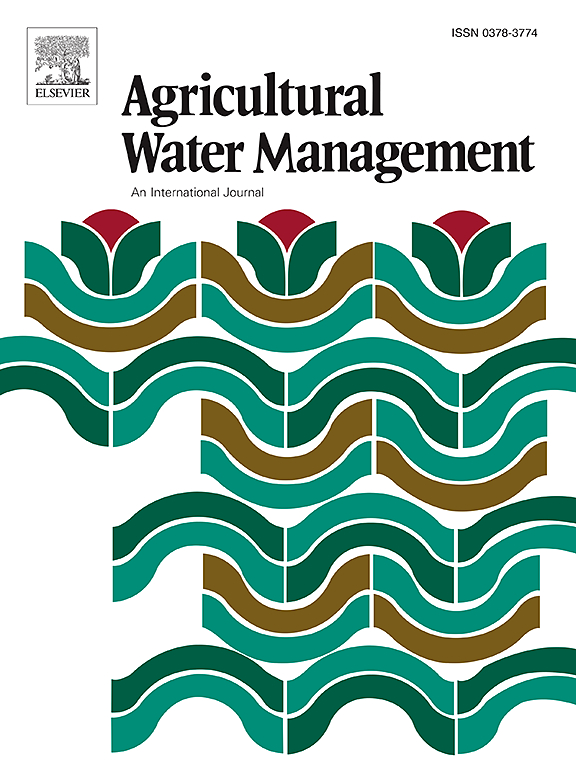Quantifying the rainfall variability effects on crop growth and production in the intensified annual forage - winter wheat rotation systems in a semiarid region of China
IF 5.9
1区 农林科学
Q1 AGRONOMY
引用次数: 0
Abstract
Replacing summer fallow period (July to September, SF) with annual short-season forages in the traditional fallow-winter wheat (Triticum aestivum L.) system may maintain grain yield and improve productivity in the semi-arid environments. But the uneven and variability rainfall led to instable productivity of the annual forage–winter wheat cropping system. The aims of this study were to 1) quantifying rainfall variability effects on annual forage–winter wheat system crop growing process and productivity; 2) determine the optimal annual forage–winter wheat production system that will response better to future climate change. A four-year (2016–2020) field experiment was conducted to investigate the impact of replacing summer fallow period with annual forages including oat (FO, Avena sativa L.), soybean (SB, Glycine max L.), and vetch (FV, Vicia sativa L.) on plant height (H), leaf area index (LAI), and above-ground biomass (AByield) growth index dynamics under three different levels of rainfall manipulation i.e. 30 % of ambient rainfall exclusion (R-30 %), natural rainfall (CK), and 30 % of ambient rainfall increase (R+30 %). Additionally, we assessed the correlations between forage and winter wheat production with growing season precipitation across 12 rainfall scenarios. Average forage biomass values of oat, soybean, and vetch were 5.50, 4.29, and 2.82 t ha−1, respectively during summer fallow period. The average winter wheat grain yield values in SF, FO, SB, and FV were 3.78, 3.12, 4.02, and 3.18 t ha−1, respectively. Integrating oat into fallow period had negative effects on wheat growth and production, and the H, LAI, and AByield for FO were 63.7 %, 50.9 %, and 29.9 % lower than SF in dry year, but the wheat grain yield in SB were 18.2 % and 24.8 % greater than SF in normal and wet years. Across the four growing seasons, the forage and wheat yields were shown to be strongly related to precipitation, and increasing precipitation significantly enhanced the production. In 2016–2017 growing season, LAI of wheat in SF, FO, SB, and FV with R+30 % scenario was increased by 30.2 %, 21.7 %, 32.7 %, and 19.8 % and that with R-30 % scenario decreased by 23.2 %, 17.8 %, 24.7 %, 16.5 % compared CK, respectively. The traditional summer fallow practice had advantage for maintaining stability in wheat gain production, especially under dry years. In consideration of forage and wheat production to rainfall variability, integrating soybean into fallow season may be an efficient option to maintain wheat yield and produce high forage amount under future climate change on the Loess Plateau and similar semi-arid regions.
量化降雨量变化对中国半干旱地区强化一年生牧草-冬小麦轮作系统中作物生长和产量的影响
在传统的休耕-冬小麦(Triticum aestivum L.)系统中,用一年生短季牧草取代夏季休耕期(7 月至 9 月,SF),可在半干旱环境中保持粮食产量并提高生产力。但降雨的不均匀性和多变性导致一年生牧草-冬小麦种植系统的生产力不稳定。本研究的目的是:1)量化降雨多变性对一年生牧草-冬小麦系统作物生长过程和生产率的影响;2)确定能更好地应对未来气候变化的最佳一年生牧草-冬小麦生产系统。开展了一项为期四年(2016-2020 年)的田间试验,以研究用燕麦(FO,Avena sativa L.)、大豆(SB,Glycine max L.)和薇菜(FV,Vicia sativa L.)等一年生牧草替代夏季休耕期对植株高度(H)、产量(P)和降雨量(R)的影响。在三种不同的降雨控制水平下,即排除 30% 的环境降雨(R-30%)、自然降雨(CK)和增加 30% 的环境降雨(R+30%),植株高度(H)、叶面积指数(LAI)和地上生物量(AByield)生长指数的动态变化。)此外,我们还评估了 12 种降雨情况下牧草和冬小麦产量与生长季降水量之间的相关性。夏季休耕期间,燕麦、大豆和薇甘菊的平均牧草生物量值分别为 5.50 吨/公顷、4.29 吨/公顷和 2.82 吨/公顷。SF、FO、SB 和 FV 的冬小麦平均籽粒产量分别为 3.78 吨/公顷、3.12 吨/公顷、4.02 吨/公顷和 3.18 吨/公顷。将燕麦纳入休耕期对小麦生长和产量有负面影响,在干旱年份,FO的H、LAI和AByield分别比SF低63.7%、50.9%和29.9%,但在正常年份和潮湿年份,SB的小麦产量比SF高18.2%和24.8%。在四个生长季中,牧草和小麦的产量与降水密切相关,降水的增加显著提高了牧草和小麦的产量。在 2016-2017 生长季,与 CK 相比,R+30% 情景下 SF、FO、SB 和 FV 的小麦 LAI 分别增加了 30.2%、21.7%、32.7% 和 19.8%,R-30% 情景下的 LAI 分别减少了 23.2%、17.8%、24.7% 和 16.5%。传统的夏季休耕法在保持小麦产量稳定方面具有优势,尤其是在干旱年份。考虑到饲草和小麦产量对降雨量变化的影响,在黄土高原和类似的半干旱地区,将大豆纳入休耕期可能是在未来气候变化下保持小麦产量和生产大量饲草的有效选择。
本文章由计算机程序翻译,如有差异,请以英文原文为准。
求助全文
约1分钟内获得全文
求助全文
来源期刊

Agricultural Water Management
农林科学-农艺学
CiteScore
12.10
自引率
14.90%
发文量
648
审稿时长
4.9 months
期刊介绍:
Agricultural Water Management publishes papers of international significance relating to the science, economics, and policy of agricultural water management. In all cases, manuscripts must address implications and provide insight regarding agricultural water management.
 求助内容:
求助内容: 应助结果提醒方式:
应助结果提醒方式:


